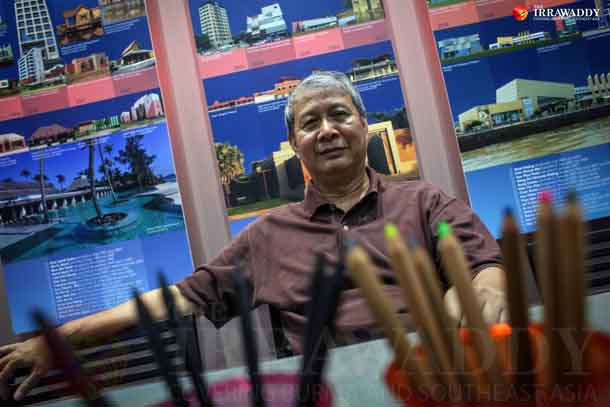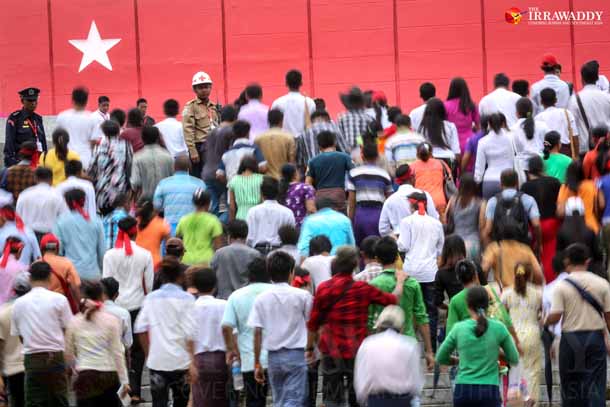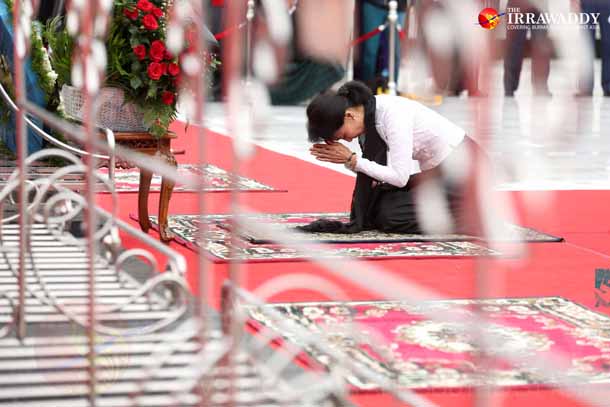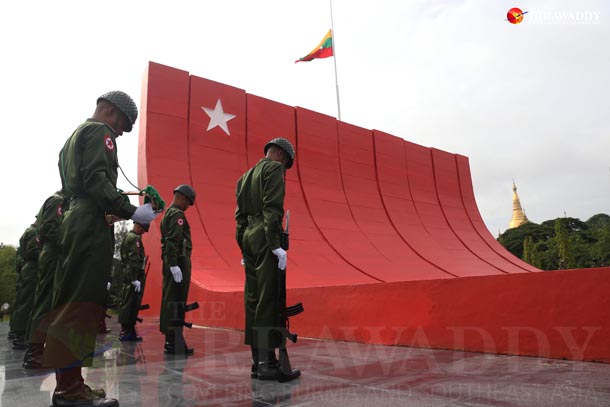RANGOON — Just after North Korean operatives remotely detonated bombs they had hidden in the ceiling of the Martyrs’ Mausoleum in Rangoon, Sun Oo received a long-distance phone call.
“Are they safe?” asked the caller in a worrisome tone before telling Sun Oo, who was in Mandalay at the time, about the bloody blast of 1983. The “safety” in question had nothing to do with people but rather was referring to architectural survey drawings of the site drafted months before.
“My professor was calling because he was worried that the drawings had been leaked to the North Koreans. So I told him they were safe at our department in the Rangoon Institute of Technology,” Sun Oo, an architect, recalled 33 years after the bombing.

The Oct. 9 blast at the mausoleum where Burmese national independence hero Aung San and his eight colleagues are interred was an attempt to assassinate South Korean President Chun Doo-hwan who was on an official visit to Burma. He was scheduled for a wreath-laying ceremony at the monument on that day. The president narrowly escaped the bombing but 17 other people in his delegation, including four high-ranking ministers, were killed.
Thanks to the explosion, the building that housed the tombs was badly damaged, and needed to be rebuilt for the annual Martyrs Day commemoration which falls on July 19 to mark the 1947 assassination of Gen Aung San, the father of Burma’s State Counselor and de facto leader Aung San Suu Kyi, and his colleagues. For many Burmese, paying respect to the leaders at the mausoleum has been a ritual repeated for nearly seven decades.

In mid-1984, then-dictator Ne Win’s government formed a 12-member “Special Task Group” led by Sun Oo to work on a new mausoleum design. The reconstruction was completed the following year.
The massive red mausoleum, adorned with a large white star on the upper left hand side, should have been the crowning achievement of his career. But for the last 32 years, Sun Oo, now president of the Association for Myanmar Architects, has felt little pride in the large red mausoleum.

“It’s nothing more than a structure. It lacks the core spirit it should have conveyed,” said the veteran architect.
“What they should have there, for example, are inscriptions of extracts from Aung San’s famous quotes. When Martyrs’ Day comes, his speeches should be played on a PA system while people are paying respect,” the 61-year-old said.
“What lies inside is of huge sentimental value to the people,” he added. “But you can’t see anything related to the leaders there now.”
Sun Oo is not exaggerating.
Until recently, the names of the nine interred were nowhere to be seen on the red mausoleum, which is located near the Shwedagon Pagoda. There are no pictures of the martyrs on the main platform, large enough to hold 600 people. Even the entrance gate lacks a sign which could educate visitors on the significance of the site.
“Anything related to Gen Aung San and the other leaders has been intentionally wiped out,” said Sun Oo.
Hiding the History
After the conceptual design for the new mausoleum was approved by the cabinet in April 1984, Sun Oo received an order to meet with the government’s chief architect.
During the meeting, the official asked him to jot down what he dictated: “Firstly, the new design of the mausoleum may not be a dedication to Gen Aung San and his colleagues. Second, if possible, it has to be a memorial site for ‘every martyr.’”
“It was the first time in my life I had ever heard they were trying to wipe out the identity of Gen Aung San and his colleagues,” Sun Oo recalled. “I had never thought that they could be that ruthless especially to Gen Aung San, who was the founder of the Burmese Army. But on that day I heard it with my own ears.”
Maw Lin, the current Vice Chairman of Association for Myanmar Architects, was a member of a Special Task Group that worked on the new design of the mausoleum. He said Ne Win’s regime wanted to remove Aung San and the other leaders from history, even in 1984.
“They rebuilt it, because they had to, but they tried their best to hide the significant roles of the leaders,” he said.
Their attempt to erase the martyrs, especially Aung San, from people’s memories intensified after the rise of Aung San’s daughter as a leader of the Burmese pro-democracy movement following the 1988 students’ uprising. Everything related to Aung San was pushed from view by the then-military dictatorship.

His portrait at government schools and offices was later replaced with former junta leader Snr-Gen Than Shwe. On Burmese banknotes, Aung San’s image was replaced with the lion, the insignia of the military regime.
The Martyrs’ Day ceremony was not an exception. Public access to the mausoleum on July 19 was restricted until 2010 because the military government was afraid of the public gathering there.
Senior military leaders were rarely seen attending the event. In 2008, Rangoon’s City Development Council, a municipal body, managed the Martyrs’ Day ceremony, and until 2011, the mayor was the most senior person to attend. Even under the previous government, Thein Sein, a former general-turned-president, never attended.
Yan Myo Thein, a Rangoon-based political commentator, said Ne Win and successive military regimes wanted to remove Aung San from public memory because of his overwhelming political legacy.
“Even though he was assassinated in 1947, Gen Aung San still is influential and earned respect from the people. U Ne Win may have been jealous of that,” he explained.
“The military regime at the time might have felt worried because what they were doing was contrary to what Gen. Aung San planned as the founder of the army,” he added, referring to the army’s repressive rule over the civilians and wars on ethnic groups in the border areas. The general believed the army should protect the people, not bully them.
Pushing the Envelope
Despite the orders to take out the identities of the martyrs, Sun Oo and his colleagues skillfully concealed additional spaces in their design for museum, inscriptions and plaques for their biographies and speeches “to add the spirit” to the mausoleum in the future. The authorities who reviewed the design were not aware of these details and approved it.
“We added them with a faint expectation that they could be used someday,” said Sun Oo.
With the new civilian government led by Aung San Suu Kyi, he is hopeful that his expectations will be met. While State Counselor Suu Kyi goes every year, people are excited at the prospect of the country’s President Htin Kyaw attending this year’s commemoration on July 19 at the mausoleum. If he does, he will be the first Burmese head of state to celebrate Martyrs’ Day publicly in many decades.

Currently, renovations are underway at the mausoleum in preparation for this year’s, 69th Anniversary of Martyrs’ Day. Sun Oo and the other architects who designed the monument had several meetings with authorities to put the spirit and legacy of Aung San and his colleagues back into the mausoleum. They are now waiting on the final approval from general’s daughter.
“If she wants us to make it happen, it will not be difficult for us because we have already prepared for it many years ago,” he said.
















